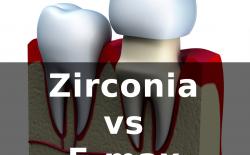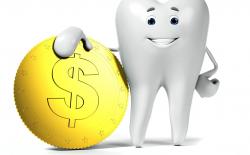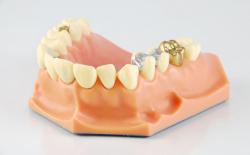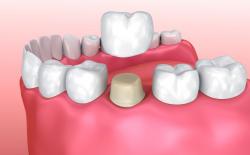What is the E-max system?
E-max is an all-ceramic system that is based on lithium disilicate glass and consists of quartz, lithium dioxide, phosphoroxide, alumina, potassium oxide, and trace elements.
The crown is usually milled from a single block of ceramic, which makes it very tough and durable. CAD / CAM technology makes it possible to get a crown in a single sitting.
E-max based all-ceramic prostheses are rapidly gaining widespread popularity in cosmetic dentistry due to their excellent esthetics, durability, and strength.
The E-max system is mainly indicated for the fabrication of crowns and veneers in the anterior region.
E-max is also the ideal choice for short-span bridges in the anterior region.
A video by Ivoclar Vivadent North America about the history and advantages of IPS e.max. Duration: 2:24
How much does an E-max crown cost?
The average price of an E-max crown in the United States is around $1,100 - $1,600.
In the United Kingdom prices start around £500, prices in Canada are pretty close to US prices and Australians have to pay a 10% - 20% extra.
E-max is a very high-quality crown, but it doesn't come cheap.
While it's impossible to provide an exact price, we tried to gather the usual prices from a few different countries. Please note that prices might differ significantly based on your exact location, the experience of the dentist, the size of the tooth, etc...
So here are the average E-max crown prices in various countries:
- United States: $1,100 - $1,600
- United Kingdom: £500 - £900
- Canada: $1,100 - $1,600
- Australia: $1,200 - $1,800
Need a local dentist?
What are the benefits of the E-max system?
E-max based prostheses possess several advantages, which make them ideal for the fabrication of fixed prostheses in the anterior region:
- The best match to your natural teeth: An important esthetic requirement for all-ceramic prostheses is that they should possess sufficient translucency that matches your natural teeth. E-max crowns possess an ideal blend of translucency and lifelike appearance, which makes them suitable for the restoration of front teeth. They are more translucent than zirconia crowns!
- All-ceramic prostheses: E-max based prostheses do not contain any metal alloy beneath the porcelain. This means that an unsightly grey line of an underlying metal will not be visible at the gumlines, and the crowns will look just like your natural teeth.
- Durability: E-max crowns are prepared from lithium disilicate, which is a glass-ceramic and possesses excellent strength. Thus, E-max crowns are less likely to crack or fracture during clinical usage. They are less likely to chip when compared to zirconia crowns!
- Ability to be milled: Another benefit of E-max crowns is that they can be quickly fabricated by using CAD-CAM milling. E-max crowns are prepared from a high-quality monolithic block of lithium disilicate. All the dentist needs to do, is to prepare the teeth, make a digital impression, and feed It into the CAD-CAM machine software, and voila! E-max crowns are ready for cementation!
- Conservation of tooth structure: Since E-max crowns possess excellent strength and fracture resistance, these crowns can be prepared in very thin sections. This not only ensures optimal esthetics but also requires minimal removal of natural tooth structure during preparation. The more tooth structure you have, the better your oral health is. When you have more tooth structure, your tooth stands stronger.
- Multiple options for teeth restoration: The best thing about the E-max system is that it is not limited to crowns only. This system can also be used to fabricate veneers, inlays, onlays, overlays, and even short-span bridges to replace front teeth.
A short video with before-after pictures of a smile makeover with E-max crowns. Duration: 1:05.
Disadvantages of E-max crowns
While E-max has many great characteristics, that makes it a popular choice among dentists and patients, there are a few cons that you should be aware of before making a decision:
- High price: The superior looks and the durability of E-max come at a higher price.
- Not ideal for posterior/back teeth: Though rare, E-max crowns may fracture when we try to fit them on your occlusal/biting surfaces. This is because they are thin. These crowns are more suitable for front teeth where you don’t use them for hard biting. If you want to use E-max for posterior teeth because of esthetic reasons, the dentist needs to trim your teeth more so that the crown can get enough thickness to seat. The strength of your crown always depends on the thickness. The thicker the crown, the better it withstands biting forces.
- May not suit darker teeth: As E-max is more translucent than zirconia, they look more natural than zirconia. However, if the natural color of your teeth is on the darker side, zirconia might be a better choice.
- Suitable only for smaller bridges: E-max is suitable for replacing only a single tooth. It may not withstand forces for replacing more than one tooth.
E-max crowns and onlays in a dental lab.
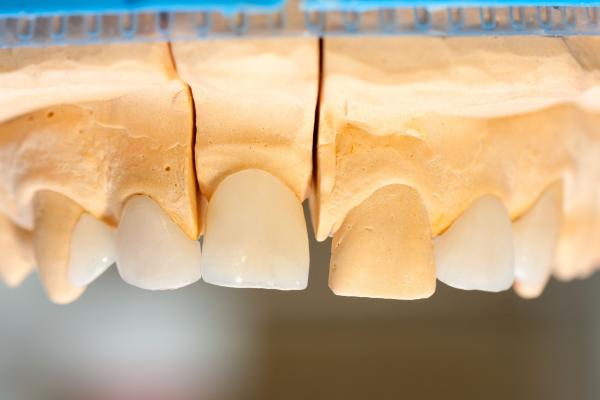
Is an E-max crown right for you?
The E-max all-ceramic crowns offer a cosmetic solution for the correction of the following esthetic problems:
- Stained teeth: Say goodbye to your stained teeth with the E-max crowns and veneers. These all-ceramic prostheses are highly translucent and possess excellent fracture and chipping resistance.
- Crooked teeth: E-max crowns can also be used to restore the structure and shape of crooked teeth, especially in the anterior region.
- Root canal treated teeth: Teeth on which root canal procedures have been performed tend to become brittle and fragile. E-max crowns offer an excellent blend of esthetics as well as strength for restoring such teeth.
- Fractured teeth: Teeth that got fractured either due to extensive cavities or trauma, can also be restored with Emax crowns.
If you need restoration for your front teeth, E-max is definitely a choice to consider.
How are E-max crowns prepared?
E-max crowns can be prepared both in a dental lab and in the office.
If you want a same-day crown, E-max can be quickly and conveniently prepared in the dental office.
- Your dentist will first prepare your teeth by removing a thin layer of the natural tooth structure.
- A digital impression of your teeth will be made with the help of an intraoral camera. You don’t need a messy impression with a paste here.
- This impression is then transmitted to the computer that controls the milling procedure.
- Your dentist matches the shade of the crown with your natural teeth.
- The milling machine cuts the monolithic block of lithium disilicate to produce the required shape of the prosthesis.
- Finally, your dentist fits the crown on your tooth, makes any fine adjustments if needed, and glues it on.
This means you can get a crown on the same appointment, within 1-2 hours. No waiting for the permanent crown, no multiple appointments, and no impressions, no need for a temporary crown.
A short video about E-max crown preparation. Duration: 1:38.
Newer versions of E-max
There are newer, modified, and better varieties of E-max available these days.
IPS e.max ZirPress is a combination of lithium disilicate and zirconium dioxide, wherein lithium disilicate is pressed on to zirconium dioxide for enhancing its properties.
The good news is even with a thickness of 1 mm, E-max crowns carry a flexural strength of 500 MPa! (Flexural strength is the ability to withstand forces before a prosthesis fracture.)
There are two varieties of Emax trending for CAD-CAM these days:
- IPS e.max CAD is a lithium disilicate glass-ceramic block that is highly esthetic.
- IPS e.max ZirCAD zirconium oxide which has an improved strength. They are more suited for posterior bridges.
Another variety of E-max known as IPS e.max Press Abutment Solutions is suitable for implants. It combines a titanium base (Ti base) with the lithium disilicate glass-ceramic to give you an implant-supported hybrid restoration.
Frequently asked questions
Are E-max crowns good?
Yes! E-max crowns are durable, look very natural, require minimal removal of tooth structure.
More often than not E-max is a great choice if you need dental crowns.
However, be sure to consult with your dentist, as E-max might not be the ideal solution to your particular dental problem.
How long do E-max crowns last?
With proper oral care, E-max crowns can last significantly longer than the average 5-15 years lifetime of dental crowns.
Can E-max crowns stain?
No, provided that you take care of your crown so that its surface is not damaged.
If you are regularly eating or drinking certain foods, e.g. coffee or red wine, stains can appear on the surface of the crown.
However, if the crown is not damaged, professional cleaning by your dentist can easily remove these surface stains.
Can you whiten E-max crowns?
No, dental crowns cannot be whitened.
It is recommended to get a professional cleaning, maybe teeth whitening, before selecting the right shade of a dental crown.
Need a local dentist?
You might also be interested in:
Dental Crown Costs
How much do dental crowns cost? The average price is around $1,000 and $1,500, but prices vary widely. Find out what factors affect the price of a dental crown!
Gold Dental Crowns
Gold dental crowns are the most durable crowns, they often last for a lifetime. Read our article to find out why gold is such great material for dental crowns!
How Long Do Dental Crowns Last?
While the average lifetime of a crown is 5-15 years, many crowns last a lot longer than that. Learn more about the most important factors that determine the longevity of a dental crown!
